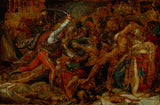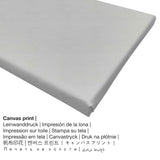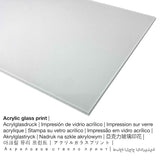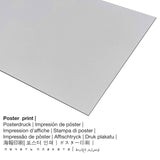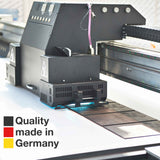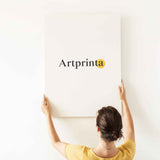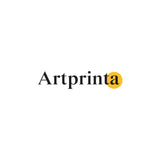Anne-Louis Girodet de Roucy-Trioson, 1809 - Sketch maka nnupụisi na Cairo - mbipụta nka mara mma.
Ụtụ gụnyere. Mbupu gbakọrọ na ndenye ọpụpụ.
Ozi zuru ezu gbasara akụkọ
In 1809 na nwoke artist Anne-Louis Girodet de Roucy-Trioson made this 19th century artpiece. The 210 ụdị afọ nke masterpiece tụrụ nha: Nhazi: 25 x 33 x 6,5 cm (9 13/16 x 13 x 2 9/16 na); Ekebereghị: 15,2 x 23,3 cm (6 x 9 3/16 na) e were kwa ihe-ọcha tee ya oil on paper, mounted on paper and canvas. Taa, ọrụ nka gụnyere na Ụlọ ihe ngosi nka nke Cleveland nchịkọta dijitalụ, nke bụ otu n'ime ụlọ ngosi ihe mgbe ochie n'ụwa nile nke na-ewu, na-echekwa, na-amụ ihe, ma na-ekesa nchịkọta nkà ya pụtara ìhè site n'oge niile na akụkụ nke ụwa, na-emepụta akwụkwọ mmụta na nghọta ọhụrụ, mgbe ọ na-eje ozi dị ka ebe ọha na eze na ọgụgụ isi maka ya. obodo. Site n'ikike nke Velọ ihe ngosi nka nke Cleveland (ikikere - ngalaba ọha). Ihe kredit nke ọrụ nka bụ: Gift of Eugene Victor Thaw. Ọzọkwa, alignment bụ odida obodo ma nwee oke nke 3: 2, nke pụtara na ogologo bụ 50% ogologo karịa obosara. The writer, painter Anne-Louis Girodet de Roucy-Trioson was a European artist from France, whose art style was primarily Neoclassicism. The European painter lived for a total of 57 afọ a mụrụ ya n'afọ 1767 in Montargis, Centre region, France and deceased in the year 1824 in Paris, Ile-de-France, France.
Supplemental description from The Cleveland Museum of Art website (© Nwebiisinka - Ụlọ ihe ngosi nka nke Cleveland - www.clevelandart.org)
Several months after Napoleon's 1798 invasion of Egypt, rebellion erupted in Cairo. French troops viciously suppressed the uprising, including a massacre in the Al-Azhar Mosque of Mamelukes, an all-male group of warriors who occupied much of the Middle East at the time. Napoleon chose this subject for the artist, but because no documentation or eyewitness reports survived, Girodet freely interpreted the event. Interest in Mamelukes gripped France at this time. To ensure a steady supply of new recruits, Mamelukes enslaved and trained boys from across the Ottoman Empire, and the group at the right demonstrates Girodet's fascination with their racial diversity and perceived homoeroticism.
Data ndabere gbasara akụkụ nka mbụ
| Aha nka: | "Sketch forThe Revolt at Cairo" |
| Nhazi: | sere |
| Okwu mkpokọta: | nkà nke oge a |
| Century: | 19th narị afọ |
| Emepụtara n'afọ: | 1809 |
| Ogologo afọ nka nka: | ihe dị ka afọ 210 |
| Ihe osise izizi: | oil on paper, mounted on paper and canvas |
| Akụkụ izizi (ọrụ nka): | Nhazi: 25 x 33 x 6,5 cm (9 13/16 x 13 x 2 9/16 na); Ekebereghị: 15,2 x 23,3 cm (6 x 9 3/16 na) |
| Egosiputara na: | Velọ ihe ngosi nka nke Cleveland |
| Ebe ngosi nka: | Cleveland, Ohio, United States nke America |
| Dị n'okpuru: | www.clevelandart.org |
| Ụdị nka nka: | ngalaba ọha |
| Site n'aka: | Velọ ihe ngosi nka nke Cleveland |
| kreditline ọrụ nka: | Gift of Eugene Victor Thaw |
Tebụl nkọwa omenkà
| aha: | Anne-Louis Girodet de Roucy-Trioson |
| Aha ndị ọzọ: | Girodet de Roucy Anne-Louis, Roucy Anne-Louis Girodet de, Girodet-Trioson, Girodet Ann-Louis, Roussy Anne-Louis Girodet de, Girodet de Roussy-Trioson Anne-Louis, Girodet de Roucy Trioson Anne-Louis, Girodet de Roucy-Trioson Anne-Louis, M. Girodet, Girodet de Roussy Anne-Louis, Girodet-Trioson Anne-Louis, Trioson Anne Louis Girodet de Roussy, Girodet Triosone, Girodet Anne-Louis, Anne Louis Girodet-Trioson, Girodet-Trioson Anne Louis, Girodet-Trioson Anne Louis de Roussy, Anne Louis De Roussy Girodet-Trioson, Trioson Anne-Louis Girodet-, Girodet de Roucy Trioson Anne Louis, Anne Louis Girodet De Roussy, Girodet Anne-Louis de Roucy-Trioson, Girodet de Roussy Anne Louis, Girodet Anne Louis de Roucy Trioson, Anne-Louis Girodet de Roucy-Trioson, Girodet-Trioson Anne Louis Girodet de Roussy, Girodet, Girodet de Roucy-Trioson Anne-Louise, Ann-Louis Girodet |
| Gender: | nwoke |
| Nationality: | French |
| Ọrụ: | odee, onye na-ese ihe |
| Obodo obibi: | France |
| Nhazi nke onye nka: | omenkà nke oge a |
| Ụdị nka: | Neoclassicism |
| Nwụrụ na afọ nke: | 57 afọ |
| Afọ ọmụmụ: | 1767 |
| Ebe omuma: | Montargis, mpaghara Center, France |
| Afọ ọnwụ: | 1824 |
| Nwụrụ na (ebe): | Paris, Ile-de-France, France |
Ihe ndị ahịa anyị nwere ike isi na ya nweta
Anyị na-enye ụdị nha na ihe dị iche iche maka ngwaahịa ọ bụla. Ị nwere ike ịhọrọ n'ime nhọrọ nhazi ngwaahịa ndị a:
- Mbipụta enyo acrylic: The print on acrylic glass, often referred to as a plexiglass print, will convert your favorite artwork into great home décor. In addition to that, it is a good alternative to canvas or aluminium dibond art prints. Your favorite artwork is manufactured thanks to the help of state-of-the-art UV direct printing technology. This has the effect of deep, vivid colors. The major benefit of an acrylic glass art print is that contrasts plus granular color details will be more identifiable thanks to the granular tonal gradation.
- Kwaaji: A canvas direct print is a printed canvas mounted on a wooden stretcher. A canvas has the distinctive effect of three dimensionality. What is more, printed canvas makes a charming and comfortable look. Your canvas print of this artwork will allow you to transform your into a large artwork as you would see in a gallery. The great advantage of canvas prints is that they are relatively low in weight, which implies that it is easy and straightforward to hang up the Canvas print without the support of additional wall-mounts. Hence, canvas prints are suitable for all types of walls.
- Mbipụta akwụkwọ mmado (akwa akwa akwa): Our poster print is a printed canvas with a slightly roughened surface finish. The poster print is appropriate for framing the art replica with a custom-made frame. Please bear in mind, that depending on the size of the canvas poster print we add a white margin 2-6cm round about the work of art in order to facilitate the framing.
- Mbipụta aluminom (aluminium dibbond): These are metal prints on aluminium dibond material with a true depth. The Direct Print on Aluminum Dibond is your ideal start to fine reproductions produced with aluminum. For the Print On Aluminum Dibond, we print the chosen artwork right onto the surface of the white-primed aluminum. The white & bright parts of the work of art shine with a silk gloss, however without any glare.
Nkọwa ngwaahịa ahaziri ahazi
| Bipụta ngwaahịa: | ọmarịcha nka |
| Mmeputakwa: | dijitalụ mmeputakwa |
| Usoro mmepụta: | mbipụta dijitalụ (Mbipụta UV ozugbo) |
| Nlụpụta: | emepụtara na Germany |
| Ụdị ngwaahịa: | na mmepụta ihe |
| A na-atụ aro iji ngwaahịa eme ihe: | mgbidi gallery, foto mgbidi |
| Ndozi onyonyo: | nhazi odida obodo |
| Oke akụkụ onyonyo: | ( Ogologo: obosara) 3: 2 |
| Pụtara nha akụkụ onyonyo: | ogologo bụ 50% ogologo karịa obosara |
| Nhọrọ ihe dị: | ígwè obibi akwụkwọ (aluminium dibond), ebipụta canvas, mbipụta enyo acrylic (nwere ezigbo mkpuchi iko), mbipụta akwụkwọ mmado (akwụkwọ kwaaji) |
| Kanvas n'elu etiti ihe ndọtị (mbipụta akwa akwa): | 30x20cm - 12x8", 60x40cm - 24x16", 90x60cm - 35x24", 120x80cm - 47x31", 150x100cm - 59x39" |
| Mbipụta iko acrylic (nwere ezigbo mkpuchi iko) dị iche iche: | 30x20cm - 12x8", 60x40cm - 24x16", 90x60cm - 35x24", 120x80cm - 47x31", 150x100cm - 59x39" |
| Ụdị akwụkwọ mmado (akwụkwọ kwaaji) dị iche iche: | 60x40cm - 24x16", 90x60cm - 35x24", 120x80cm - 47x31" |
| Nhọrọ nha mbipụta aluminom: | 30x20cm - 12x8", 60x40cm - 24x16", 90x60cm - 35x24", 120x80cm - 47x31" |
| Igwe onyonyo: | biko buru n'uche na nnomi nka enweghi fremu |
Ederede iwu: We try everythig possible to depict the products with as many details as possible and to exhibit them visually on the various product detail pages. Still, the pigments of the printed materials and the printing can vary somehwat from the representation on the screen. Depending on the settings of your screen and the nature of the surface, color pigments may not be printed as exactly as the digital version. In view of the fact that all art reproductions are processed and printed by hand, there may as well be minor deviations in the motif's size and exact position.
Nwebiisinka © - www.artprinta.com (Artprinta)

